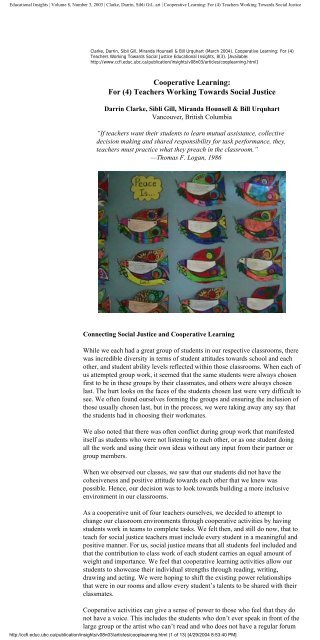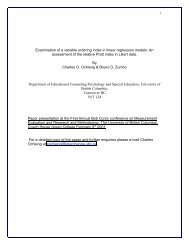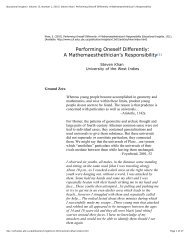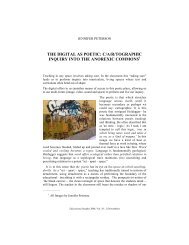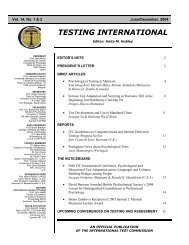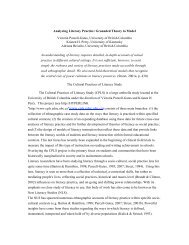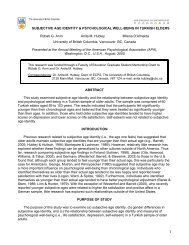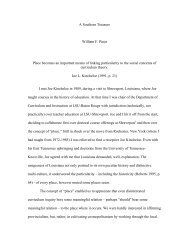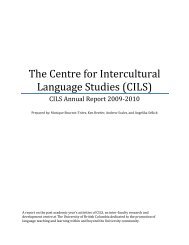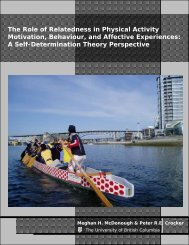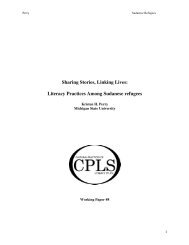Educational Insights | Volume 8, Number 3, 2003 | Clarke, Darrin ...
Educational Insights | Volume 8, Number 3, 2003 | Clarke, Darrin ...
Educational Insights | Volume 8, Number 3, 2003 | Clarke, Darrin ...
Create successful ePaper yourself
Turn your PDF publications into a flip-book with our unique Google optimized e-Paper software.
<strong>Educational</strong> <strong>Insights</strong> | <strong>Volume</strong> 8, <strong>Number</strong> 3, <strong>2003</strong> | <strong>Clarke</strong>, <strong>Darrin</strong>, Sibli Gil...art | Cooperative Learning: For (4) Teachers Working Towards Social Justice<br />
<strong>Clarke</strong>, <strong>Darrin</strong>, Sibli Gill, Miranda Hounsell & Bill Urquhart (March 2004). Cooperative Learning: For (4)<br />
Teachers Working Towards Social Justice <strong>Educational</strong> <strong>Insights</strong>, 8(3). [Available:<br />
http://www.ccfi.educ.ubc.ca/publication/insights/v08n03/articles/cooplearning.html]<br />
Cooperative Learning:<br />
For (4) Teachers Working Towards Social Justice<br />
<strong>Darrin</strong> <strong>Clarke</strong>, Sibli Gill, Miranda Hounsell & Bill Urquhart<br />
Vancouver, British Columbia<br />
“If teachers want their students to learn mutual assistance, collective<br />
decision making and shared responsibility for task performance, they,<br />
teachers must practice what they preach in the classroom.”<br />
—Thomas F. Logan, 1986<br />
Connecting Social Justice and Cooperative Learning<br />
While we each had a great group of students in our respective classrooms, there<br />
was incredible diversity in terms of student attitudes towards school and each<br />
other, and student ability levels reflected within those classrooms. When each of<br />
us attempted group work, it seemed that the same students were always chosen<br />
first to be in these groups by their classmates, and others were always chosen<br />
last. The hurt looks on the faces of the students chosen last were very difficult to<br />
see. We often found ourselves forming the groups and ensuring the inclusion of<br />
those usually chosen last, but in the process, we were taking away any say that<br />
the students had in choosing their workmates.<br />
We also noted that there was often conflict during group work that manifested<br />
itself as students who were not listening to each other, or as one student doing<br />
all the work and using their own ideas without any input from their partner or<br />
group members.<br />
When we observed our classes, we saw that our students did not have the<br />
cohesiveness and positive attitude towards each other that we knew was<br />
possible. Hence, our decision was to look towards building a more inclusive<br />
environment in our classrooms.<br />
As a cooperative unit of four teachers ourselves, we decided to attempt to<br />
change our classroom environments through cooperative activities by having<br />
students work in teams to complete tasks. We felt then, and still do now, that to<br />
teach for social justice teachers must include every student in a meaningful and<br />
positive manner. For us, social justice means that all students feel included and<br />
that the contribution to class work of each student carries an equal amount of<br />
weight and importance. We feel that cooperative learning activities allow our<br />
students to showcase their individual strengths through reading, writing,<br />
drawing and acting. We were hoping to shift the existing power relationships<br />
that were in our rooms and allow every student’s talents to be shared with their<br />
classmates.<br />
Cooperative activities can give a sense of power to those who feel that they do<br />
not have a voice. This includes the students who don’t ever speak in front of the<br />
large group or the artist who can’t read and who does not have a regular forum<br />
http://ccfi.educ.ubc.ca/publication/insights/v08n03/articles/cooplearning.html (1 of 13) [4/29/2004 8:53:40 PM]
<strong>Educational</strong> <strong>Insights</strong> | <strong>Volume</strong> 8, <strong>Number</strong> 3, <strong>2003</strong> | <strong>Clarke</strong>, <strong>Darrin</strong>, Sibli Gil...art | Cooperative Learning: For (4) Teachers Working Towards Social Justice<br />
to share his or her talents with others. Cooperative activities give those students<br />
a chance to shine in a system that often legitimizes the best readers, writers, and<br />
athletes, but does not see the inherent value in asking our students to care for<br />
each other.<br />
The activities that we carried out in our classrooms asked students, some for the<br />
first time, to listen to each other and also to rely on each other to make<br />
contributions to the activities.<br />
Connecting to the Research Literature<br />
Having discussed with one another what cooperative learning meant to each of<br />
us, the next step was to read what the literature had to say about cooperative<br />
learning.<br />
Delving into the research, such as the work by Slavin (1990), Slavin and<br />
Stevens (1990), and Kagan (1990) resulted in finding a great deal of support for<br />
cooperative learning. No one advocated against cooperative learning or even<br />
expressed reservations with it. There were authors of papers who acknowledged<br />
that there was some controversy amongst proponents of cooperative learning,<br />
but this was mainly focused on differing methods of measuring results. The<br />
authors were still in favour of cooperative learning, but questioned data<br />
collection, comparisons, and which elements to define as crucial (e.g.<br />
leadership, trust, decision making and inclusion) to cooperative learning.<br />
Our main goal was to develop a more inclusive classroom, so we turned to<br />
cooperative learning activities because they have been found to improve intergroup<br />
relations and improve social acceptance of all students (Slavin, 1990).<br />
Slavin also found that cooperative learning opportunities resulted in gains in<br />
self esteem, the liking of school and of the subject being studied, increases in<br />
time-on-task, and improvements in attendance.<br />
For cooperative learning to be successful, certain elements are required: face-toface<br />
interactions, individual accountability, group processing, and interpersonal<br />
skills (Schultz, 1990). Throughout the literature, there is an emphasis on the<br />
positive impact of group goals and individual accountability on improvements<br />
in student achievement. However, the literature does not address questions of<br />
whether or not these same elements are essential to improving inclusion<br />
(Stevens and Slavin, 1995).<br />
The research does support the use of cooperative learning opportunities<br />
generally to move a classroom towards inclusion, noting that students who have<br />
experienced this type of learning demonstrate social behaviours such as active<br />
listening and effective conflict resolution more often than do students who are<br />
studying competitively or individually (Andersen, Nelson, Fox, and Gruber,<br />
1988).<br />
But, for cooperative learning groups to function well, the social skills that<br />
students need in order to work collaboratively, such as leadership,<br />
communication, and conflict management, need to be taught. Too often teachers<br />
mistakenly assume that students have the skills necessary to interact effectively<br />
in a group. To be effective, these social skills need to be taught, assessed, and<br />
the transference of them as learned behaviour skills promoted, before beginning<br />
cooperative group work (Andersen, Nelson, Fox, and Gruber, 1988).<br />
According to studies by Slavin (1990) and Slavin and Stevens (1990), groups of<br />
two or three are the best for students engaging in cooperative learning. Also,<br />
heterogeneous groups (such as mixed ability levels) are more productive than<br />
homogeneous groups; it is recommended to assign to each group a student<br />
drawn randomly from high, medium, and low ability groups to foster<br />
heterogeneity (Andersen, Nelson, Fox, and Gruber, 1988). Our experiences<br />
make it hard to embrace this generalization. At times, it is in the best interest of<br />
the students to work in groups which allow them to benefit from the richness of<br />
the diversity, but at other times this richness can be overwhelming for a student<br />
with more limited skills, who may, in the face of it, shut down. Grouping based<br />
on similarity of needs is sometimes the route to go.<br />
To implement cooperative learning, Kagan (1990) recommends the use of<br />
organized structures. Structures usually involve a series of steps with prescribed<br />
behaviours at each step. Structures lend themselves to any subject area and are<br />
exemplified by such teaching strategies as "round robin," “think-pair-share,”<br />
and “jigsaw.” Individual accountability and working towards a common group<br />
goal are inherent in structures such as these, giving students experience with<br />
these crucial elements.<br />
Having reviewed the literature, the common themes that emerged for us as<br />
http://ccfi.educ.ubc.ca/publication/insights/v08n03/articles/cooplearning.html (2 of 13) [4/29/2004 8:53:40 PM]
<strong>Educational</strong> <strong>Insights</strong> | <strong>Volume</strong> 8, <strong>Number</strong> 3, <strong>2003</strong> | <strong>Clarke</strong>, <strong>Darrin</strong>, Sibli Gil...art | Cooperative Learning: For (4) Teachers Working Towards Social Justice<br />
necessary for cooperative learning to occur were:<br />
• common group goals<br />
• individual accountability<br />
• social skills training.<br />
These are the elements we worked to ensure were in place in our classrooms<br />
when we set up our cooperative learning situations.<br />
Throughout the literature, the “success” of cooperative learning was measured<br />
by the achievement of students taught in cooperative learning situations as<br />
compared to that of students in control groups who were not. However,<br />
cooperative learning also has a positive impact on inter-group relations, self<br />
esteem, attitudes towards class and school, and the ability to work<br />
collaboratively with groups (Stevens and Slavin, 1995). The “success” of<br />
cooperative learning processes should also give consideration to gains in these<br />
areas.<br />
Unfortunately, also lacking from the research was the voice of students. It<br />
appeared that no data were obtained from students working in cooperative<br />
situations with regard to their feelings about cooperative learning or their<br />
preferences for cooperative learning in relation to other teaching and learning<br />
strategies.<br />
Four Site Experiences<br />
After having achieved a better understanding of the dynamics necessary for<br />
successful experiences with cooperative learning, we decided to try it out with<br />
our classes. The four snapshots that follow represent our individual experiences<br />
with cooperative learning and inclusion in our classrooms. The first two explore<br />
themes from student responses in a Grade 3 and Grade 2 class, respectively. The<br />
last two focus on observations of student interactions, one of a Grade 3, 4, 5<br />
multi-age grouping and the other in a Kindergarten/Grade 1 split.<br />
From the Classroom of <strong>Darrin</strong> <strong>Clarke</strong><br />
“I felt great because everyone participated…” (Mike)<br />
I am a teacher in a suburban elementary school. I have been teaching for seven<br />
years, the last six at my present school. In my school district, elementary school<br />
is Kindergarten to Grade 5. Over my six years, I have taught every grade from<br />
K to Grade 5. When I conducted the research for this study, I was teaching a<br />
class of twenty-two Grade 3 students. The class consisted of low to middle class<br />
students. There were a few students who had recently emigrated from Eastern<br />
Europe, the rest were second or more generation Canadians. Within the class<br />
there were fourteen boys and eight girls. The academic range in the class was<br />
fairly narrow, with all student achievement profiles fitting within norms for that<br />
grade.<br />
Having spent time equipping the students with common group goals, a sense of<br />
individual accountability, and the interaction skill of listening—all key elements<br />
for successful engagement in cooperative learning—it was time to engage the<br />
students in cooperative learning activities. After each activity (see Appendix A<br />
for descriptions of the activities), the students in my class reflected, in a written<br />
format, on their experience in the group. Some guiding questions that they<br />
considered while they were reflecting included:<br />
1) Rate the group on how they worked.<br />
2) How did you feel?<br />
3) What did you like?<br />
4) What did you not like?<br />
5) What would you do differently next time?<br />
6) How did this activity compare to the last one?<br />
What follows is an analysis of the data gathered from those reflections. After<br />
reading over the students’ reflections, four themes emerged: Group Size,<br />
Interaction Skills, Decision Making, and Emotions/Feelings.<br />
The first topic that resonated throughout the students’ feedback was Group Size.<br />
Here is a sampling of what they had to say:<br />
Jane: It depends what activity we are doing then I can decide if I want to<br />
be in apartnership or group.<br />
Emily: I liked there were only two people...it wasn’t too noisy...better than<br />
last time because there were too many people.<br />
Karen: ...it would be hard because with only two people you would not get<br />
a lot of ideas.<br />
Jay: It is easier when there are four or five people in a group.<br />
Jay: Next time I would like to have more people in the group.<br />
http://ccfi.educ.ubc.ca/publication/insights/v08n03/articles/cooplearning.html (3 of 13) [4/29/2004 8:53:40 PM]
<strong>Educational</strong> <strong>Insights</strong> | <strong>Volume</strong> 8, <strong>Number</strong> 3, <strong>2003</strong> | <strong>Clarke</strong>, <strong>Darrin</strong>, Sibli Gil...art | Cooperative Learning: For (4) Teachers Working Towards Social Justice<br />
I was pleased with the students’ consideration of group size. I found the<br />
comment by Jane “... it depends what activity we are doing, then I can decide if<br />
I want to be in a partnership or group...” to be particularly powerful. Through<br />
experiencing a variety of cooperative learning scenarios, this student was able to<br />
conclude that her learning was based on subject/topic expectations and these<br />
would determine which learning circumstances would best suit her needs:<br />
partnership, group of three or group of some other size.<br />
This voice both supports and contradicts Anderson, Nelson, Fox and Gruber<br />
(1988) in their findings that suggest groups of two or three are ideal. Their<br />
findings reflect data on achievement only. Jane’s voice points out that, yes,<br />
sometimes groups of two or three provide the best conditions for learning, but at<br />
other times, and for a variety of reasons, a larger group is better. The students’<br />
insights on group size go beyond the literature I have read. Students recognize<br />
that they, as individuals, can and need to decide how they can best work. As<br />
Emily expressed it, “...I liked there were only two people...it wasn’t too<br />
noisy...better than last time because there were too many people.…” Similarly,<br />
Jay perceived that the work was easier in a group of four.<br />
Students realize that partnerships lend themselves to positive interactions, but<br />
that ideas are constrained in them by the limited number of people. They also<br />
recognized that larger groups are challenging because of the turn taking and<br />
listening dynamics involved, but that the responsibilities in them are shared and<br />
they hold out the potential for a more expansive idea pool. I think that these<br />
observations reflect important distinctions that could only be made by students<br />
who had gone through having the experience of participating in different<br />
cooperative groupings.<br />
The second topic that dominated student feedback was that of Interaction Skills.<br />
Some of the comments students made in this area were:<br />
Cory: I felt happy because everybody got to talk, we did this by<br />
talking in a circle.<br />
Bob: One thing I did learn was that if you all talk at the same time<br />
you won’t getanywhere and your presentation won’t be that good<br />
either.<br />
Arthur: What I like about this group is that before we went to<br />
something else we would first see if everyone agreed.<br />
Tim: ...next time we should try to use better listening skills and give<br />
everyone more of a chance.<br />
Cory: I learned to listen more doing this activity.<br />
Cam: ...next time I’ll choose a group that I know will listen.<br />
The literature highlighted the importance of social interaction skills in preparing<br />
for cooperative learning opportunities. It wasn’t until I read the students’<br />
reflections that I understood that this feature is critical. I was quickly reminded<br />
that successful social interactions are based on active listening. Therefore,<br />
before the students engaged in further cooperative learning tasks, I taught active<br />
listening skills. Students contributed ideas and suggested behaviours that<br />
demonstrated active listening. These included appropriate body language and<br />
paraphrasing. In the words of Cory: “I felt happy because everybody got to talk,<br />
we did this by taking turns in a circle.” Conversely, students such as Bob noted<br />
that a lack of social skills had a negative impact on their sense of success,<br />
“...one thing I did learn was that if you talk at the same time you won’t get<br />
anywhere and your presentation won’t be that good either.…”<br />
The student feedback pointed out that social skills go beyond active listening<br />
and that time needs to be spent on taking turns, providing positive feedback and<br />
engaging in conflict resolution. Teaching these skills is important because, as<br />
educators, we cannot assume that students possess these abilities. Even teaching<br />
listening skills does not guarantee that the students will employ them as Cam<br />
indicated: “...next time I’ll choose a group that I know will listen.…” To equip<br />
my students to have successful, positive, cooperative learning experiences, I<br />
need to teach other skills, like decision-making, too.<br />
The third topic that emerged in student comments was Decision Making. What<br />
follows is a sampling of what they had to say:<br />
Mike: I felt good because there was no arguing and I listened.<br />
Bob: It was tough working with this group because I was the one who<br />
usually had to calm everyone down.<br />
Karen: ...tough...putting the story together because we had a lot of ideas<br />
and we couldn’t put all the ideas in.<br />
Cam: ...we didn’t work together...we had to use rock, paper, scissors.…<br />
http://ccfi.educ.ubc.ca/publication/insights/v08n03/articles/cooplearning.html (4 of 13) [4/29/2004 8:53:40 PM]
<strong>Educational</strong> <strong>Insights</strong> | <strong>Volume</strong> 8, <strong>Number</strong> 3, <strong>2003</strong> | <strong>Clarke</strong>, <strong>Darrin</strong>, Sibli Gil...art | Cooperative Learning: For (4) Teachers Working Towards Social Justice<br />
When students don’t possess appropriate decision making skills, they resort to<br />
what they know, decision-making processes that don’t involve reason, like rock,<br />
paper scissors. Students recognized that the most challenging aspect of<br />
cooperative learning is making group decisions. As Karen noted, it was<br />
“...tough putting the story together because we had lots of ideas and we couldn’t<br />
put all the ideas in.…” Students also felt the power of effective decision-making<br />
when they encountered it. As Mike observed, “...I felt good because there was<br />
no arguing and I listened .…”<br />
The fourth key topic was students’ Emotions/Feelings. This theme was carried<br />
in student comments such as:<br />
Karen: I felt happier because I did not have to talk to 3 other people<br />
and I got a chance to write a lot.<br />
Mitch: ...felt great ...everybody was listening to me.<br />
Karen: I did not feel very good because not everyone in the group was<br />
listening to me.<br />
The range of emotions experienced by students covered a broad spectrum. Some<br />
reported they felt great and good while others, like Karen, reported negative<br />
emotions, “I did not feel very good because not everyone was listening to<br />
me.…” Interestingly, most of the feelings the students described related directly<br />
back to the use (or lack thereof) of interaction skills. Students felt good when<br />
being listened to and heard, and poorly when there was a breakdown in the use<br />
of positive interaction techniques. This reinforces the importance of teaching<br />
interaction skills, and of ensuring that transference of them is encouraged in a<br />
wide range of situations.<br />
If cooperative learning is going to work to achieve inclusion, then students must<br />
be properly equipped to handle the responsibilities (e.g., of being members of<br />
functioning groups). Clearly, when students do not have the skills to work in<br />
groups, groups can become emotionally charged, a situation which leads to a<br />
poor learning environment which, in turn, certainly does not contribute to a<br />
sense of inclusiveness in the class.<br />
At the outset of this project, my goal was to create a better sense of inclusion in<br />
my classroom. The problem with assessing my success in relation to this goal is<br />
that there was no baseline data on inclusiveness in my classroom against which<br />
to make a direct comparison. In my professional judgment, my classroom did<br />
develop a greater sense of inclusion following the development of interactive<br />
skills and the use of cooperative activities. Initially, one of my concerns was<br />
that groups had been formed based on popularity and friendship, without<br />
considering any other factors. However, the latest examples of my students<br />
forming into groups demonstrates that group formation is more than the simple<br />
finger pointing at friends that it used to be. It has become a thoughtful, dynamic<br />
and successful experience for students, one that takes into account different<br />
needs in different learning contexts.<br />
From the Classroom of Bill Urquhart<br />
“I liked it when we were listening and we loved both of our ideas.” (Claire)<br />
I am a primary teacher in a suburban elementary school located in the city of<br />
Port Coquitlam. I have been teaching for seven years, the last six at my present<br />
school. In my school district, elementary schools are arranged from<br />
Kindergarten to Grade 5. Over my six years I have had the opportunity to teach<br />
http://ccfi.educ.ubc.ca/publication/insights/v08n03/articles/cooplearning.html (5 of 13) [4/29/2004 8:53:40 PM]
<strong>Educational</strong> <strong>Insights</strong> | <strong>Volume</strong> 8, <strong>Number</strong> 3, <strong>2003</strong> | <strong>Clarke</strong>, <strong>Darrin</strong>, Sibli Gil...art | Cooperative Learning: For (4) Teachers Working Towards Social Justice<br />
grades from Kindergarten to Grade 3. At present, I am teaching a class of<br />
twenty-one Grade 2 students. The class consists of a group of low to middle<br />
class students. Within this class there are eleven boys and ten girls and the<br />
academic range is quite broad including students working at a late Grade 3 level<br />
in many subject areas and others working at a beginning Grade 1 level in all<br />
academic areas. Overall, this group of students interacted very well with each<br />
other.<br />
My continuing quest is to gain a stronger understanding of cooperative learning.<br />
For this study, my goal was to expose my students to cooperative learning tasks<br />
that would encourage group formation in a more spontaneous, inclusive manner<br />
than they had been using to date.<br />
For the purpose of this study, students were asked to participate in the<br />
following:<br />
1) a series of five Language Arts-based cooperative lessons<br />
(see Appendix A for a description of these)<br />
2) class debriefs<br />
3) reflection worksheets<br />
As I reviewed the students’ written and oral reflections after each cooperative<br />
activity, as well as my own observations, I began to note themes of Decision<br />
Making, Inclusion, Leadership, Academic Support, and Off-Task Behaviours<br />
emerging. Each of these themes is explored below.<br />
As the following student comments suggest, a major concern for students<br />
centred on the issue of Decision Making:<br />
• “Everyone said their thinking—we had a vote—no one<br />
fought—only one choice.”<br />
• “Our group was good because we [didn’t fight] over who should go<br />
first. We voted and [stuck] with it.”<br />
• “…we first decided if we wanted to vote or not and we decided yes.<br />
We voted for Sue’s ideas….”<br />
As a teacher observer, I noticed students:<br />
• using a voting system of raising hands, secret ballots to decide<br />
which story version they wanted to share with the class.<br />
• negotiating participation opportunities. One student exclaimed, “If<br />
you get to write, then I get to circle the words!”<br />
• using a tally sheet to record peers’ story choice.<br />
I was impressed with how students created processes, (e.g., secret ballots,<br />
raising of hands, tallies, etc.) in order to solve various problems such as who<br />
gets to handle the pictures first, whose story will be used for the purpose of<br />
sharing, who gets to write first and, who gets to handle the pictures/props first.<br />
This act of ‘decision making,’ as indicated in the students’ reflections, had an<br />
impact on all of them as they worked in their cooperative groups. Moreover,<br />
this was an area of cooperative learning in which students needed to further<br />
develop their skills. Researchers, Bonnie K. Natasi and Douglas H. Clements<br />
(1991) further support this assertion when they suggest that teachers must teach<br />
and model conflict resolution skills such as negotiation, compromise, and<br />
cooperative problem solving.<br />
A second theme emerged around the topic of Inclusion. Students noted:<br />
• “It was fun because we usually don’t get to work with partners.”<br />
• “I think it was [great] to get to work with the people I never get to<br />
work with. It was kind of like a way to make people have friends.”<br />
• “I liked how we worked together and I liked how everybody was<br />
cooperating and listening.”<br />
• “What was good I think was my group all got to arrange a part of the<br />
story.”<br />
As an observer, I noticed the following examples of ‘inclusion’ as the<br />
cooperative learning activities played out:<br />
• Claire, a shy student, is handed a piece of paper. She is slow to<br />
respond, but her group moves around her in a very positive and<br />
supportive manner.<br />
• Sylvia, a weak student, shares her ideas. Her partners are sitting and<br />
listening patiently as she slowly expresses her thinking.<br />
• Sally, while organizing the pictures, attempts to involve Joe, a weak<br />
student, by asking him, “Joe, you tell us what you want.”<br />
The literature strongly supports my finding that cooperative learning activities<br />
help to create a more inclusive environment (Natasi and Clements, 1991, Gilles<br />
http://ccfi.educ.ubc.ca/publication/insights/v08n03/articles/cooplearning.html (6 of 13) [4/29/2004 8:53:40 PM]
<strong>Educational</strong> <strong>Insights</strong> | <strong>Volume</strong> 8, <strong>Number</strong> 3, <strong>2003</strong> | <strong>Clarke</strong>, <strong>Darrin</strong>, Sibli Gil...art | Cooperative Learning: For (4) Teachers Working Towards Social Justice<br />
and Ashman, 2000, and Slavin, 1987). As a result of doing these cooperative<br />
activities many students felt more included.<br />
A third theme focused on ‘Academic Support.’ Students said:<br />
• “We all came close together to listen and help people write and<br />
listen to their story.”<br />
• “People were helping to figure out a story or helping to spell<br />
words.”<br />
• “I felt good working with my partner because we took turns writing<br />
and when one person was writing the other was thinking of a story and<br />
telling it.”<br />
• “Billy told me how to spell words. It was great!”<br />
These students’ reflections, and my own observations, reaffirmed the important<br />
role that cooperative learning tasks can play in supporting the academic<br />
development of children (particularly those who are academically challenged).<br />
Researchers Robyn M. Gilles and Adrian F. Ashman also support these claims.<br />
They assert that when students with academic challenges interact with their<br />
peers, they receive feedback and support (scaffolding) that help them clarify<br />
issues and build understandings (Gilles, Ashman, 2000). Similarly, they suggest<br />
that these reciprocal interactions probably serve to maintain the interest of lowachieving<br />
students in group tasks, while at the same time supporting their<br />
efforts to solve problems and construct new understandings (Gilles, Ashman,<br />
2000). I couldn’t agree more!<br />
A final theme that emerged focused around Off-task Behaviours. Students<br />
shared the following comments:<br />
• “One kid in our group wasn’t listening and we had to retell the story<br />
again so that person could learn the story. That’s why I found it<br />
challenging.”<br />
• “Tony was not listening to Sally and he kept on switching the two<br />
pieces of paper [even] when Sally told him no…he kept on doing it.”<br />
• “I saw my partner talking to Alyssha….”<br />
• Janice and Lisa were bothering us by playing with my stuffed<br />
animals and goofing off so it was very hard to work. So I picked the<br />
number 5.”<br />
• “Sometimes they were being so goofy. And sometimes they were so<br />
noisy. Next time we do this I want a new desk group….”<br />
When I reviewed the students’ reflections and my own observations, it became<br />
very apparent to me that many students lacked the necessary skills to complete<br />
parts of a cooperative activity successfully. I’ve realized that although I’ve<br />
always been a big advocate of cooperative learning, I haven’t really taught my<br />
students these skills. Students didn’t really know what was expected and I could<br />
see off-task behaviours that I would attribute to this skill gap.<br />
My quest now is to take steps to reduce the amount of off-task behaviour that<br />
continues to take place during cooperative learning activities. For this, I will<br />
depend heavily on the many suggestions for helping support students become<br />
more aware of the interpersonal skills and group behaviours required for<br />
successful cooperative learning that can be found in articles by Slavin (1987),<br />
and Gilles and Ashman (2000).<br />
From the Classroom of Sibli Gill<br />
http://ccfi.educ.ubc.ca/publication/insights/v08n03/articles/cooplearning.html (7 of 13) [4/29/2004 8:53:40 PM]
<strong>Educational</strong> <strong>Insights</strong> | <strong>Volume</strong> 8, <strong>Number</strong> 3, <strong>2003</strong> | <strong>Clarke</strong>, <strong>Darrin</strong>, Sibli Gil...art | Cooperative Learning: For (4) Teachers Working Towards Social Justice<br />
“We got more ideas when we worked together…” (Tim)<br />
I teach in a school that encourages teachers to collaborate in their planning and<br />
teaching, and I team teach with another Grade 3, 4, and 5 teacher. At the time of<br />
the study, my class consisted of twenty-three Grades 3, 4 and 5 students who<br />
were from a variety of cultural, social and economic backgrounds. Most<br />
students were designated English as a second language learners; a few were<br />
English as first language learners. Student achievement levels in the class were<br />
within the widely held expectations for children of their ages for all except three<br />
students whose achievement levels were academically lower than all other<br />
students. There were no students with an official special needs designation in<br />
my class.<br />
Through observation over the school year, I have noticed no cultural barriers<br />
among the friendships within the class. Culture, original language, and religion<br />
did not figure in who the students mixed with socially and this extended into the<br />
classroom when they chose people to sit or work with. Not coincidentally, the<br />
students who I feel were isolated from the other students were the three students<br />
who have significant learning issues. These three students were socially able<br />
and were included in play at recess and lunchtime, but when it came to studentchosen<br />
groups to work with in the class, these three were consistently left out.<br />
During my observations of the group work for the activity “Building from<br />
Clues” (see Appendix A for a description of this activity), I focused for a few<br />
minutes on one group. This group included a little boy named Tim who is<br />
academically far behind his counterparts. As I observed him sitting passively,<br />
and listening and watching the other students in the group boisterously doing<br />
the activity, the question I asked myself was, “What is Tim gaining right now?”<br />
As I continued to observe, I noticed that Tim wasn’t passive, but was actually<br />
engaged; his eyes were bright, he was keenly aware of his group and their ideas<br />
as they shared them, and twice he gave a yes or no response to the ideas of the<br />
others. This realization reminded me that not all students can and should play<br />
the same role in group situations. Students who need to, will quietly observe<br />
until they are ready to step into another role and feel comfortable enough to do<br />
so. In this case, Tim needed to see the modeling available from other students as<br />
they engaged in cooperative group work many more times before he would be<br />
ready to take a more active role in that work. So the answer to my question,<br />
“What is Tim gaining right now?” is that he was gaining valuable time to<br />
observe his peers and to learn from and with them.<br />
Although my initial perception about this student was that he was very passive<br />
in his role in the cooperative group activities, I now believe that students like<br />
him gain much more when they are quietly observing members of a group than<br />
they do when they are alone. Students working on their own are not always<br />
engaged in active learning. Further, by working alone they miss the opportunity<br />
to see, and therefore learn, many skills like organization, communication,<br />
facility with language, and critical thinking. I believe that all students learn<br />
differently and the role that they play in a group is the role that they need to<br />
play in order to learn effectively at any particular time. This does not mean that<br />
some months or years later the role will be the same; quite likely it will change<br />
and this will be due to the modelling that they have seen in the past.<br />
Consequently, I have revised my outlook on all students and instead of trying to<br />
make them fit into some standard that I think as a teacher they need to reach, I<br />
believe it is much more valuable for these students to do what they need to do in<br />
order to be successful learners. One of the essential features of cooperative<br />
learning is that the success of one student helps other students be successful.<br />
Cooperative learning supports all learners because the structure and activity<br />
associated with cooperative learning itself allows for contributions of many<br />
different kinds: artistic, verbal, social, written, and beyond.<br />
Inclusion in the classroom is an important step towards social justice. Students<br />
can be taught that working together and making everybody feel included is an<br />
important endeavour because it allows us all to feel good about each other and<br />
about ourselves. The responsibility for teaching this life lesson is one that is<br />
shared by everyone in the classroom, not just the teacher. Hopefully this<br />
understanding and this sense of responsibility translates into actions well<br />
beyond the confines of a classroom.<br />
Robert E. Slavin suggests in his book Cooperative learning: Student teams<br />
(1989), that when students are taught that the classroom is a place of<br />
individualistic competition, it follows that it is also a place of embarrassment, of<br />
anger, and of an established pecking order. In such a place, students are<br />
unwilling to help each other and may go as far as calling each other names<br />
when one performs better than the others. Slavin then asks the reader to imagine<br />
a structural change in the classroom. In this restructured classroom, students are<br />
http://ccfi.educ.ubc.ca/publication/insights/v08n03/articles/cooplearning.html (8 of 13) [4/29/2004 8:53:40 PM]
<strong>Educational</strong> <strong>Insights</strong> | <strong>Volume</strong> 8, <strong>Number</strong> 3, <strong>2003</strong> | <strong>Clarke</strong>, <strong>Darrin</strong>, Sibli Gil...art | Cooperative Learning: For (4) Teachers Working Towards Social Justice<br />
asked to work together. Now, the goal is to see what they can do while working<br />
together. In this situation, students will want to make sure that everybody in the<br />
group has a good understanding of the activity. They will each feel responsible<br />
for each other’s learning.<br />
Thomas F. Logan (1986) states that, “if teachers want their students to learn<br />
mutual assistance, collective decision making and shared responsibility for task<br />
performance, they, teachers, must practice what they preach in the classroom”<br />
(Logan, p.125). My students are able to see how my teaching partner and I work<br />
cooperatively to plan and teach the classes. This modelling will encourage<br />
students to help each other, teach each other, and make more of a group effort.<br />
From the Classroom of Miranda Hounsell<br />
“We are a team…” (Jesse)<br />
I teach in a small annex on the East Side of Vancouver in an area that draws<br />
students from a range of ethnic communities. Every one of my students speaks<br />
English as their second language. The neighbourhood is working class, but my<br />
class includes students from households that range from very needy to quite<br />
well off. This year my class consists of fourteen Grade 1 and four Kindergarten<br />
students.<br />
I was surprised to find out how much I enjoyed “spying” on my students. It was<br />
freeing to be able to sit back and really focus on the conversations between the<br />
students instead of feeling the pressure to step in, interfere, and keep the<br />
students on task and working towards completing an assignment. Frankly, I was<br />
curious to see how they worked together and not whether they finished the task<br />
to the best of their abilities.<br />
For purposes of ensuring everyone contributed to an activity using Venn<br />
diagrams (see Appendix A for a description of the activity), the comparison of<br />
their favourite things was the perfect topic. Everyone was on task because they<br />
each needed to contribute their thoughts to be able to complete the task. Each<br />
team was unique and brought a different approach to the task. One group<br />
recorded only the things that they had in common. Other groups were looking at<br />
anything and recorded each favourite thing, whether they had it in common or<br />
not. They seemed excited regardless of their findings.<br />
Jesse and Steven were the group that seemed to struggle the most. Steven, who<br />
is a high functioning Kindergarten student capable of writing a perfectly spelt<br />
sentence or two, was fooling around and off topic. Jesse, who is an emergent<br />
speller in Grade 1, struggled to keep Steven on track by asking him questions<br />
about things that he liked.<br />
On the carpet for the debrief I asked the students what they thought about<br />
working with a teammate. Steven put his hand up and responded that he really<br />
really really really really really liked working with a teammate. I responded by<br />
asking him to, “Tell me more. What was the best part?” He said he liked having<br />
turns. Steven rated group work on the 0 to 10 scale as 100.<br />
Before sending them off to their journals to record in writing and drawing what<br />
it was like to work with a partner, I told them I hoped that they would share<br />
their honest feelings. If it was hard then I wanted to see a zero. I wanted their<br />
true feelings and thoughts; I didn’t want them to rate the activity a 10 because<br />
they thought that is what I wanted. To encourage honesty, I made sure that<br />
students knew their journals would not be shared with any other students.<br />
http://ccfi.educ.ubc.ca/publication/insights/v08n03/articles/cooplearning.html (9 of 13) [4/29/2004 8:53:40 PM]
<strong>Educational</strong> <strong>Insights</strong> | <strong>Volume</strong> 8, <strong>Number</strong> 3, <strong>2003</strong> | <strong>Clarke</strong>, <strong>Darrin</strong>, Sibli Gil...art | Cooperative Learning: For (4) Teachers Working Towards Social Justice<br />
For many of my Kindergartener’s and Grade 1’s, writing is still a struggle. They<br />
are able to be far more expressive and verbose in their feelings orally. The<br />
actual job of writing bogs them down. So, as the students worked, I walked<br />
around and talked to some of them, feeling as though I might get more out of<br />
them through the more informal medium of conversation in which they could<br />
more comfortably express themselves. I was particularly interested in what<br />
Steven was going to say, because of the striking difference between what I had<br />
observed during the activity and what I had heard in the debrief on the carpet.<br />
Looking in his writing book, I saw that Steven had given the teamwork a zero<br />
and said, “My partner did not let me do anything.” I wasn’t too sure what to<br />
think. I went to look at Jesse’s book and he had rated group work a 10, and had<br />
written down “It was fun.” At this point I became aware of how vital on-thespot<br />
observations were going to be for me.<br />
Looking back, I can see that if I am looking at this study as a way to include<br />
every student and encourage them to have more caring attitudes towards each<br />
other, then it was reasonably successful, even though Steven’s journal entry<br />
suggested he wasn’t overly thrilled with the experience. What I saw was two<br />
students who don’t choose to play with each other talking and exchanging ideas,<br />
even if they were off topic and discussing Pokemon cards! Jesse showed a great<br />
deal of persistence in attempting to recapture Steven’s attention and to focus<br />
him on their assignment.<br />
Reflections<br />
Where do I even start to describe what I have learned through this experience? I<br />
don’t think that there is an easy answer to that question. I have learned the<br />
importance of action research. I always felt that I could just read a book, talk to<br />
my colleagues or instinctively know what was best for my students, but I have<br />
come to realize that there is a whole wide world full of practical researchers<br />
who are there (like my teachers) to offer assistance and guidance with both<br />
practical questions and processes that enable you to research your own<br />
questions. These guides are there to light my way and to give me perspective<br />
and some insight into topics about which they have much more information than<br />
I do.<br />
An article by Roger T. Johnson and David W. Johnson called “How can we put<br />
co-operative learning into practice?” (1987) spoke to me directly as a practising<br />
teacher who is interested in delving into co-operative learning. It deals<br />
specifically with questions that I had, and it helped me focus on where I might<br />
get started as a researcher. It encourages teachers to replicate well known<br />
studies on student interaction, saying, “Every careful replication adds to our<br />
understanding” (p.47). The authors share their own research topics and carefully<br />
explain the questions they have and how they are going to go about answering<br />
them. For example, they think that co-operative learning best suits situations<br />
that involve problem solving, decision-making, and critical thinking, and they<br />
wonder why co-operative groups “handle these tasks better than students<br />
working alone” (p.48). This question was similar to the one that I started with in<br />
the beginning. After combining the background knowledge from articles and<br />
my own experiences with implementing co-operative learning situations in my<br />
classroom, I have come to the conclusion that cooperative learning does help<br />
shape a more positive classroom environment.<br />
The more time my students have spent working cooperatively in a variety of<br />
groups, the less time I have had to spend working on social problems. Mistakes<br />
that the students make are now more often shrugged off with the words, “That’s<br />
okay, we all make mistakes,” than they were before they had experience with<br />
cooperative learning. One of my students, who is a non-reader but an extremely<br />
talented artist, was able to shine in each of the groups in which he worked.<br />
Other students noticed his abilities when working with him, and commented on<br />
them. No longer did he feel that he had nothing to contribute to group work; he<br />
had his artwork, which opened other students’ eyes to both his amazing<br />
imagination and keen intellect. I can see that it could have been extremely easy<br />
to lose this student because he felt that he did not measure up to the others in<br />
terms of his reading and writing.<br />
These activities have opened all of our eyes (his, the other students, and my<br />
own) to the fact that everyone has talents in different areas, and everyone can<br />
contribute to learning. This student has become more confident in all aspects of<br />
school life and is making wonderful progress, not only in his reading and<br />
writing, but also in terms of his behaviour. For him alone this research has been<br />
such a positive experience that I would continue to use as many cooperative<br />
learning activities as I can in the future.<br />
It is true that the more you do cooperative learning activities, the easier they<br />
become for the students. You have to experience an activity a number of times<br />
http://ccfi.educ.ubc.ca/publication/insights/v08n03/articles/cooplearning.html (10 of 13) [4/29/2004 8:53:40 PM]
<strong>Educational</strong> <strong>Insights</strong> | <strong>Volume</strong> 8, <strong>Number</strong> 3, <strong>2003</strong> | <strong>Clarke</strong>, <strong>Darrin</strong>, Sibli Gil...art | Cooperative Learning: For (4) Teachers Working Towards Social Justice<br />
before it becomes familiar enough that the students are comfortable with the<br />
format and can relax and truly experience cooperative learning. The more my<br />
class was thrown together in cooperative learning situations, the easier it was<br />
for them. The atmosphere created by cooperative learning activities carried over<br />
into other aspects of classroom life as well, and we all began to refer to<br />
ourselves as a team. Our team worked together when problems with students<br />
from other classes arose out on the playground, as well as when they had to<br />
choose partners for games during their free time.<br />
Our cooperative ethos also spilled over into how the class lined up. A discussion<br />
began when one student asked whether they had to save someone’s spot in line<br />
when a student had to go back to get something that they had forgotten. As a<br />
class we sat and discussed the relative merits of saving a space and not saving<br />
one. Those who shared their ideas for saving a spot in line used terms such as<br />
“we are a team,” “it is nice to be friends with everyone,” and “sometimes people<br />
make mistakes and that’s alright.” All of the positive support that I had hoped to<br />
see at the beginning of this investigation was coming out and pervading all<br />
aspects of our class.<br />
I plan to scream what I have learned through this study from the rooftops. This<br />
is important because we teach more than academics. So much time can be spent<br />
fixing little problems and complaints that you feel more like a social worker<br />
than a teacher. I truly believe that a positive classroom environment means<br />
everything. It allows the learning to happen for every student. Listening to other<br />
teachers in the staff room, I realize that many of the problems they are having<br />
are social ones, like the ones that I have seen in my own room. These problems<br />
can be addressed, and student attitudes and behaviours can be changed in<br />
positive ways. I have seen such a massive change in terms of these things in my<br />
students already that I know that cooperative learning activities can help do this<br />
in other classrooms too. I now cannot wait until September. I will be starting<br />
these activities with my new class and can only imagine what might be.<br />
Bringing the Four Voices Back Together: Concluding Remarks<br />
Although the initial objective the four of us shared was to create a more<br />
inclusive tone in our respective classrooms, we discovered that, while we<br />
worked towards that goal, our focus shifted to cooperative learning and the<br />
skills necessary to achieve it.<br />
As a group we found that the literature we read on cooperative learning was<br />
consistent with our research findings. Common group goals, individual<br />
accountability and social skills training did appear to be necessary ingredients<br />
for successful cooperative learning to occur.<br />
Our research was twofold involving: our experience as a group of collaborating<br />
teachers, and the work we did in our individual classrooms to give our students<br />
opportunities to work collaboratively with each other through cooperative<br />
learning activities. We found our experience of collaborating on this project,<br />
and our decision to conduct research as a group of four practicing teachers, was<br />
a powerful demonstration for us of what we were reading in the literature. We<br />
are able to see the workings of our group dynamics, the four of us, and the<br />
parallels of our working relationship in our classroom practices.<br />
In the process, we recognized trust as a necessary ingredient in successful<br />
cooperative learning. At this time, this is an element that requires further<br />
investigation. Trust seemed to be naturally present among the four of us; our<br />
question is: how can trust be built in a classroom setting? This issue was not<br />
addressed anywhere in the literature we encountered.<br />
Reflecting over our action research, we are reminded of the importance of<br />
bringing the student voice into research, and of the major themes that emerged<br />
from students’ reflections and our classroom observations. Students<br />
consistently, in all four classes, reflected upon the elements of Decision<br />
Making, Listening Skills, Talking, Academic Support, Inclusion, and Feelings<br />
of Exclusion. As a result of completing this action research, we have come to<br />
value the following. We believe that:<br />
• cooperative learning is one avenue which teachers and students can<br />
embark on to create a more inclusive and socially just classroom.<br />
• students need to be explicitly taught skills in order to be successful<br />
cooperative learners.<br />
• it’s important for each school and class to have its own unique<br />
voice.<br />
• using cooperative activities in a consistent manner from<br />
Kindergarten to Grade 7 will create a more inclusive, socially just<br />
school.<br />
http://ccfi.educ.ubc.ca/publication/insights/v08n03/articles/cooplearning.html (11 of 13) [4/29/2004 8:53:40 PM]
<strong>Educational</strong> <strong>Insights</strong> | <strong>Volume</strong> 8, <strong>Number</strong> 3, <strong>2003</strong> | <strong>Clarke</strong>, <strong>Darrin</strong>, Sibli Gil...art | Cooperative Learning: For (4) Teachers Working Towards Social Justice<br />
• we, as teachers, need to model the expected behaviours related to<br />
cooperative learning in the context of cooperative learning activities and<br />
beyond them.<br />
To better facilitate an inclusive community in our classrooms we would start<br />
using cooperative learning activities at the beginning of the school year, and<br />
carry them on throughout the year. Cooperative learning activities helped us<br />
create that inclusive environment we were seeking.<br />
We are working toward social justice in our classrooms and schools by<br />
constantly asking questions, looking at our practice, giving students varied<br />
learning experiences, and by teaching cooperative learning.<br />
As inquiring practitioners we are left with some of the following questions:<br />
• How do we go about teaching the interpersonal skills and individual<br />
behaviors needed for successful cooperative learning?<br />
• Is it realistic to expect that students with cognitive and social<br />
challenges can be taught to work effectively within a cooperative group<br />
setting?<br />
• What resources are available to help us develop and strengthen<br />
students’ interpersonal skills and individual behaviors needed for<br />
successful group cooperation?<br />
It is with these questions and a strong desire to be reflective practitioners that<br />
we are hoping to make positive strides in our teaching development.<br />
Looking back, we never imagined the power of cooperative learning that we<br />
discovered over the course of this investigation. In our classrooms it has, and<br />
will continue to, influence our personal pedagogy.<br />
References<br />
Anderson, Marybeth, Nelson, Linda R., Fox, Richard G., & Gruber, Susan E.<br />
(1988). Integrating cooperative learning and structured learning: Effective<br />
approaches to teaching social skills. Focus on Exceptional Children. 20, (9), 1-<br />
8.<br />
Cohen, E. (1986). Designing group work: Strategies for the heterogeneous<br />
classroom. : London. Teachers College Press.<br />
Gibbs, Jeanne (1995). Tribes: A new way of learning and being together.<br />
Boston, Massachusetts: Center Source Systems.<br />
Gillies, R., Ashman, A. (2000). The effects of cooperative learning on students<br />
with learning difficulties in the lower elementary school. The Journal of Special<br />
Education. 34, 19-27.<br />
Halliday, John. (1988). Back to good teaching: Diversity within tradition.<br />
London: Cassell Education.<br />
Holubec, J. Edyth & Johnson, W. David & Johnson, T. Roger and Roy, Patricia<br />
(1984). Circles of learning: Cooperation in the classroom. USA: Edwards<br />
Brothers.<br />
Johnson, David W. (1984). Circles of learning. Minnesota: Association for<br />
Supervision and Curriculum Development.<br />
Kagan, Spencer (1990). The structural approach to cooperative learning.<br />
<strong>Educational</strong> leadership. 47, 12-15.<br />
Logan, F. Thomas. (1986) Cooperative learning: A view from the inside. The<br />
Social Studies. 77(1), 123-126.<br />
Natasi, K. Bonnie & Clements, H. Douglas. (1991) Research on cooperative<br />
learning: Implications for practice. School psychology review. 20(1), 110-130.<br />
Reynolds, Michael (1994). Group work in education and training: Ideas in<br />
practice, London, England: Kogan Page.<br />
Rhoades, Jacqueline & McCabe, Margaret E. (1985). Simple cooperation in the<br />
classroom: A beginner’s guide to establishing cooperative groups. Willits,<br />
California: ITA Publications.<br />
Sharan, Yael, & Sharan, Shlomo (1990). Group investigation expands<br />
http://ccfi.educ.ubc.ca/publication/insights/v08n03/articles/cooplearning.html (12 of 13) [4/29/2004 8:53:40 PM]
<strong>Educational</strong> <strong>Insights</strong> | <strong>Volume</strong> 8, <strong>Number</strong> 3, <strong>2003</strong> | <strong>Clarke</strong>, <strong>Darrin</strong>, Sibli Gil...art | Cooperative Learning: For (4) Teachers Working Towards Social Justice<br />
cooperative learning.” <strong>Educational</strong> Leadership. 47, 17-21.<br />
Shultz, James L. (1990). Cooperative learning: Refining the process.<br />
<strong>Educational</strong> Leadership. 47, 43-45.<br />
Slavin, Robert E. (1987/1988). Cooperative learning: Where behavioural and<br />
humanistic approaches to classroom motivation meet. The Elementary School<br />
Journal. 88(1), 29-35.<br />
Slavin, R. (1990). Research on cooperative learning: Consensus and<br />
controversy. Education. 47, 52-54.<br />
Slavin, Robert E. (1989). Cooperative learning: Student teams. Washington,<br />
D.C.: National Education Association.<br />
Slavin, R., Madden, N., Stevens, R. (1990). Cooperative learning models for the<br />
3R’s. <strong>Educational</strong> Leadership. 47, 22-28.<br />
Stanford, Gene (1990). Developing effective classroom groups: A practical<br />
guide for teachers. Bristol, Great Britain: Acora.<br />
Stevens, Robert J. & Slavin, Robert E. (1995). The cooperative elementary<br />
school: Effects on students’ achievement, attitudes, and social relations.<br />
American <strong>Educational</strong> Research Journal. 32(2), 321-351.<br />
Wray, David & Medwell, Jane-Poulson, Louise & Fox, Richard. (2000). The<br />
teaching practices of effective teachers of literacy. <strong>Educational</strong> Review. 52(1),<br />
75-84.<br />
About the Authors<br />
Bill Urquhart, <strong>Darrin</strong> <strong>Clarke</strong>, Miranda Hounsell, and Sibli Gill are currently<br />
teaching in the Lower Mainland of British Columbia. They have all recently<br />
obtained their Masters’ degrees and are considering Doctoral programs.<br />
http://ccfi.educ.ubc.ca/publication/insights/v08n03/articles/cooplearning.html (13 of 13) [4/29/2004 8:53:41 PM]


